



Green crackers are eco-friendly alternatives to traditional firecrackers, designed to reduce air and noise pollution. They produce lower emissions of harmful gases and particulate matter, helping protect public health and the environment. Governments promote their use during festivals to balance cultural celebrations with environmental and health concerns.
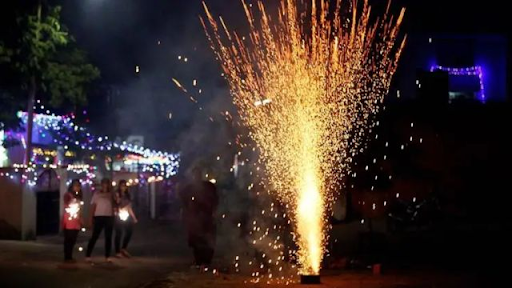
Copyright infringement not intended
Picture Courtesy: INDIANEXPRESS
The Delhi government is set to approach the Supreme Court to request permission for the use of certified "green firecrackers" during Diwali.
Green crackers are not pollution-free; they are less-polluting alternatives to conventional firecrackers, developed by the Council of Scientific and Industrial Research-National Environmental Engineering Research Institute (CSIR-NEERI).
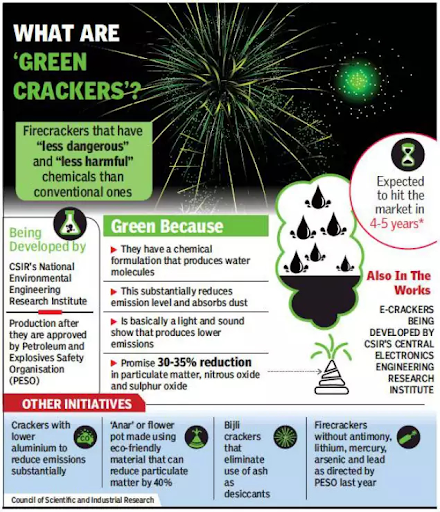
|
Component |
Pollutant/Harmful Chemical |
Impact on Health and Environment |
|
Oxidizers (for combustion) |
Potassium Nitrate, Barium Nitrate |
Barium Nitrate is highly toxic, causing severe respiratory irritation, stomach ailments, and muscle weakness. |
|
Fuel |
Charcoal, Sulphur |
Burning sulphur produces Sulphur Dioxide (SO2), a major cause of acid rain and a severe respiratory irritant that can worsen asthma and heart disease. |
|
Coloring Agents |
Strontium (red), Copper (blue), Sodium (yellow) |
Many of these are heavy metals that contaminate the air and soil. They can lead to bioaccumulation in the food chain. |
|
Binders & Stabilizers |
Dextrin, Chlorinated Polymers |
Burning chlorinated polymers can release highly toxic dioxins and furans. |
|
Noise |
Sound levels often exceed 145 decibels |
Leads to noise-induced hearing loss, high blood pressure, sleep disturbances, and severe distress to animals. |
Foundational Laws
The Explosives Act, 1884, and the Environment (Protection) Act, 1986, provide the statutory basis for regulation.
Supreme Court's Rulings
In 2018, the Supreme Court banned the sale and use of conventional firecrackers and permitted only the use of certified green crackers with reduced emissions and noise levels.
The Court explicitly banned the use of barium salts in firecrackers due to their extreme toxicity.
It also imposed time restrictions for bursting crackers during festivals (e.g., 8 PM to 10 PM on Diwali).
Role of Certifying and Licensing Bodies
CSIR-NEERI: The nodal agency responsible for the research, development, and composition of green crackers.
Petroleum and Explosives Safety Organisation (PESO): The central authority responsible for certifying and licensing manufacturers who comply with the formulations approved by NEERI.
Enforcement Agencies
Enforcement on the ground is the responsibility of State Pollution Control Boards (SPCBs) and local law enforcement, including Police and district administrations.
Environmental Protection: Reduce the emission of harmful pollutants, contributing to better air quality.
Health Benefits: Lower emissions decrease the risk of respiratory and cardiovascular diseases associated with firecracker smoke.
Safety: Green crackers are designed to be safer, reducing the likelihood of accidents and injuries.
Cultural Shift: Promoting eco-friendly alternatives reflects a societal move towards sustainable and responsible celebrations.
|
Can Festive Joy and Public Health Coexist? The debate revolves around the cultural right to celebrate against the fundamental Right to Life (Article 21), which the Supreme Court has interpreted to include the right to a clean and healthy environment. They can coexist, but it requires a fundamental shift in mindset towards responsible celebration. This involves:
|
Enforcement and Identification: It is difficult for a police officer on the street to visually distinguish a certified green cracker from a conventional or counterfeit one.
Counterfeiting and Mislabeling: Black market exists for illegal crackers that are mislabeled with fake "green cracker" branding to mislead consumers and authorities.
Availability and Cost: Certified green crackers are often more expensive and not as widely available as their traditional counterparts.
Public Awareness Gap: A large segment of the population remains unaware of the concept, benefits, or identification methods (like the QR code) for green crackers.
Supply Chain Transition: Firecracker industry needs time, technical support, and financial incentives to fully transition its manufacturing processes to meet the nationwide demand for certified products.
Strengthened Enforcement Mechanism
Create dedicated enforcement squads during festive seasons. Impose heavy penalties on manufacturers and sellers of non-compliant and counterfeit firecrackers.
Public Awareness Campaigns
Utilize government platforms like the Sameer, along with mass media, to educate the public on how to identify green crackers and the importance of responsible celebration.
Incentivize the Industry
Provide technical and financial support to manufacturers, especially small-scale units in hubs like Sivakasi, to help them transition to green cracker production.
Promote Community Fireworks Displays
Encourage Resident Welfare Associations (RWAs) and local bodies to organize controlled, community-based fireworks displays using green crackers. This reduces the scale of individual bursting and makes monitoring more manageable.
Adopting green crackers promotes sustainable celebrations. With collective efforts from government, industry, and citizens, India can balance festive joy with environmental responsibility, protecting both public health and ecological well-being.
Source: INDIANEXPRESS
|
PRACTICE QUESTION Q. How can the state balance public health with the freedom to practice religious and cultural traditions? 150 words |
Green crackers are fireworks developed by the Council of Scientific and Industrial Research (CSIR) to be less polluting than traditional firecrackers. They are formulated to reduce emissions of harmful chemicals like particulate matter (PM), sulfur dioxide, and nitrogen dioxide by 30% or more compared to conventional fireworks.
No, green crackers are not completely free of pollution. They are designed to be less harmful, but they still contain certain chemicals and produce emissions. For this reason, some experts refer to them as "less bad" rather than truly "green".
The CSIR has developed three main varieties of green crackers:
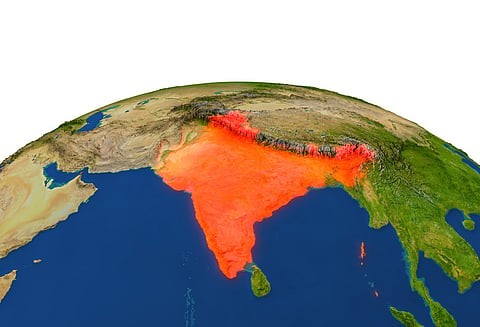
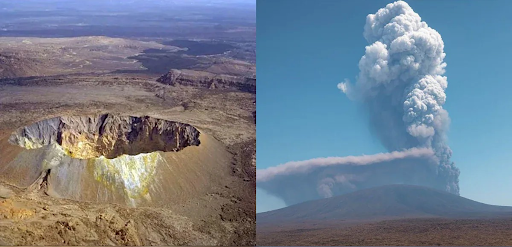
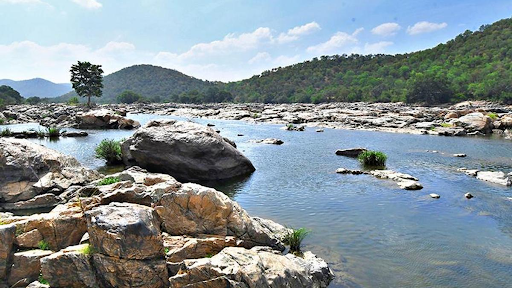

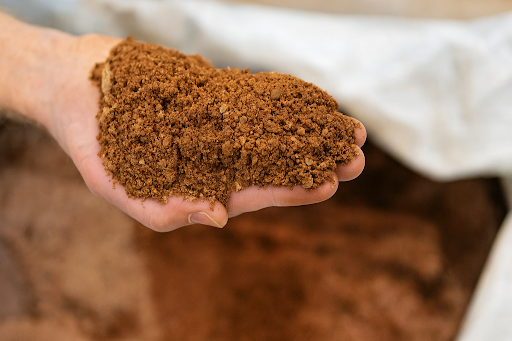

© 2025 iasgyan. All right reserved